
A Comprehensive Evaluation of Casement Windows: A Glaziers Perspective
Casement windows are a popular and versatile option for both residential and commercial buildings. Hinged on one side, they swing outward like doors, offering a unique way to allow fresh air and natural light into your space.
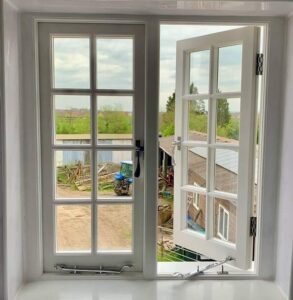
Advantages of Casement Windows
| Advantages of Casement Windows | |
|---|---|
| Ventilation | Superior airflow; excellent for hot and humid climates |
| Natural Light | Optimises natural light; reduces energy costs |
| Aesthetics | Contemporary design; contributes to aesthetic value |
| Ease of Operation | Easy to operate with a simple handle mechanism |
| Ideal for Hard-to-Reach Areas | Ideal for challenging spaces like above kitchen sinks |
Disdvantages of Casement Windows
| Disadvantages of Casement Windows | |
|---|---|
| Maintenance | Higher maintenance requirements |
| Cost | Generally more expensive than other types |
| Compatibility | Issues with flyscreens or storm windows due to outward opening |
| Size Limitations | Limited by hinge strength; larger sizes may be challenging |
Integral Parts of a Casement Window
- Sash – The sash, the window’s inner section, secures the glass panes in place.
- Glass Pane – The clear part of the window that allows light penetration and views.
- Hinges – These elements facilitate the opening and closing of the window.
- Locking Handle – This feature ensures the window’s security when closed.
- Handle – The mechanism used to open and close the window.
Types of Casement Windows
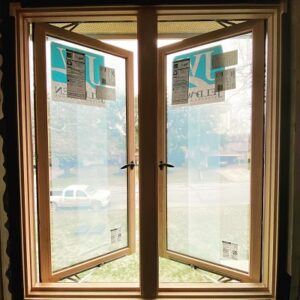
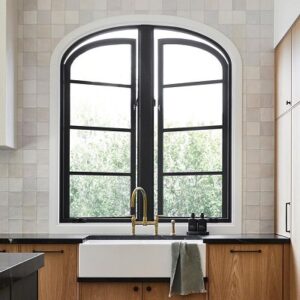
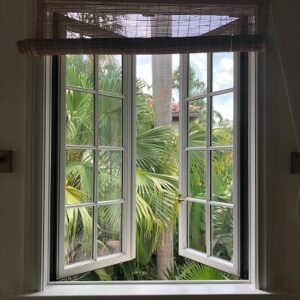
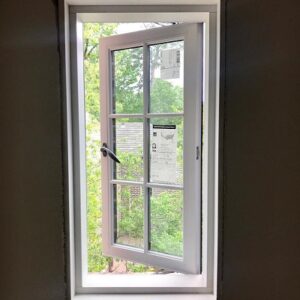
Single Frame Casement Windows
- These feature a single sash hinged to the frame, allowing outward swing for ventilation and cleaning.
- Simple and elegant design, perfect for various settings.
- Popular choice due to its affordability and ease of use.
- Boasts two sashes, providing a wider opening for increased airflow and unobstructed views.
- Ideal for maximizing ventilation and enhancing scenic views.
- Suitable for larger spaces or situations requiring increased airflow.
-
- Features sashes hinged on the side that open outwards using push handles.
- Offers a classic and traditional aesthetic, perfect for vintage-inspired homes.
- Ideal for locations where reaching a crank might be challenging.
- Comprises two sashes without a dividing post, creating a completely unobstructed view when opened.
- Swing outwards like French doors, providing maximum light and ventilation.
- Adds a timeless elegance and sophistication to any building.
- Excellent choice for classic and sophisticated architectural styles.
Casement Windows vs Other Types
| Feature | Casement Windows | Sliding Windows | Sash Windows | Louvre Windows |
|---|---|---|---|---|
| Ventilation | Superior airflow; can be fully opened | Moderate; only half the window opens at a time | Good; allows air through top and bottom sash | Excellent; adjustable for precise airflow control |
| Natural Light | Maximizes light entry due to full opening | Good light entry; limited by fixed pane | Moderate; divided sashes can obstruct light | Good; depends on angle of louvres |
| Aesthetics | Contemporary, clean lines | Sleek, minimalistic design | Classic, traditional look | Unique, adjustable slat design |
| Ease of Operation | Easy; operated with a handle | Very easy; slides horizontally | Requires some effort; vertical operation | Easy; adjustable slats |
| Suitability for Hard-to-Reach Areas | Ideal, especially for areas like above kitchen sinks | Less ideal for high or hard-to-reach areas | Not ideal for hard-to-reach areas | Depends on accessibility of adjustment mechanism |
| Maintenance | Higher due to hinges and seals | Lower; fewer moving parts | Medium; sashes and cords require maintenance | Medium; louvres need regular cleaning |
| Cost | Generally higher | Typically more budget-friendly | Can vary; often higher for authentic designs | Varies based on design and material |
| Size Limitations | Limited by hinge strength; larger sizes may not be feasible | Good for large openings | Size limited by sash balance mechanism | Limited; too large louvres can be unwieldy |
FAQ
Below are some common queries about casement windows:
How long should casement windows last?
With regular and proper maintenance, casement windows can have a lifespan of 20-25 years.
Do casement windows require maintenance?
Yes, the crank of casement windows needs to be well lubricated, and seals and hinges should be periodically inspected for any damage to prolong the window’s life.
Are casement windows more expensive than double-hung windows?
On average, casement windows cost approximately 20-30% more than double-hung windows.
What are common issues with casement windows?
Air and water leakage due to damaged or worn-out seals and hinges are common issues. Additionally, casement windows can become stuck or hard to open over time.
CALL US NOW FOR A
FREE WINDOW ASSESSMENT
Case Studies
Case Study 1: Installing Casement Windows for Mr. Thompson’s Beach House in Sydney Northern Beaches
Situation: Mr. Thompson, a resident of a beachfront property in Manly NSW, wanted to install casement windows in his home. He wanted better ventilation and more sunlight coming into his house.
What We Did: After assessing Mr. Thompson’s house and his specific needs, we designed custom casement windows. These windows had rust-proof hinges and seals to withstand the seaside weather. We installed these windows in areas where the sea breeze was the strongest.
Result: After we finished the installation, Mr. Thompson noted that his house had improved ventilation and was brighter due to more natural light. He also appreciated the modern look of the casement windows. He found that he needed to clean the windows more frequently because of the seaside conditions, but he was comfortable with it considering the significant improvements he saw in his home.

Case Study 2: Replacing Windows at Hambledon Cottage in Harris Park NSW with Casement Windows
Situation: The caretakers of a heritage building in Parramatta area wanted to replace their old windows. The new windows needed to fit the building’s historic aesthetic and improve its thermal efficiency.
What We Did: We opted for casement windows with double glazing for this job. We paid careful attention to ensuring that the design and the materials used would match the historic charm of the building and last longer.
Result: The new casement windows not only preserved the historic aesthetic but also significantly improved the building’s thermal efficiency. The caretakers were pleased with the result, even though they found the customized casement windows a little pricey. They thought the cost was justified by the reduction in their heating bills and the improved aesthetics.
Case Study 3: Installing Casement Windows in Mrs. Henderson’s High-Rise Apartment
Situation: Mrs. Henderson, an owner of a high-rise apartment in Sydney, wanted to replace her existing windows. She wanted to reduce the noise from the outside and enhance the ventilation.
What We Did: We recommended and installed casement windows with acoustic glass. These windows, known for their excellent sealing capabilities and ventilation, were installed in key areas of the apartment, such as the living room and bedrooms.
Result: Mrs. Henderson reported a noticeable decrease in noise levels and appreciated the enhanced ventilation that made her apartment feel less stuffy. She was a little inconvenienced by the inability to install flyscreens, but overall, she was very satisfied with the improved quietness and ventilation provided by the casement windows.
Key Takeaways:
- Casement windows offer superior ventilation, allowing for fresh air and improved air quality.
- They maximize natural light, brightening up your space and reducing the need for artificial lighting.
- Their simple operation and clean lines make them both aesthetically pleasing and user-friendly.
- They are energy efficient due to their tight seal and minimized air leaks.
- They can reduce noise pollution with the use of acoustic glass, creating a quieter environment.
- They come in a variety of styles and sizes, allowing you to find the perfect fit for your needs.
- By choosing casement windows, you can enjoy a healthier, brighter, and more comfortable living space.

Phillip Sharp has spent more than three decades honing his skills as a glazier in Sydney. He is currently employed at Splendid Window Glass Repairs, where he specializes in glass replacement and repair in the Sydney Eastern Suburbs area. With his wealth of experience and commitment to excellent craftsmanship, Phillip is highly respected in the industry and trusted by clients to provide top-quality work.


